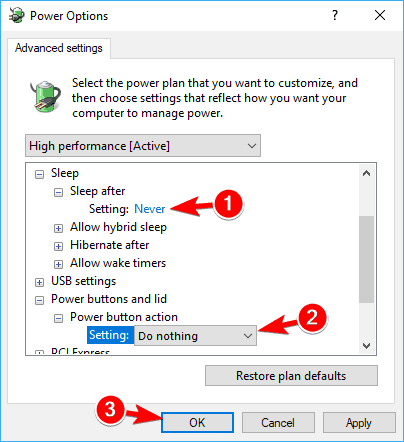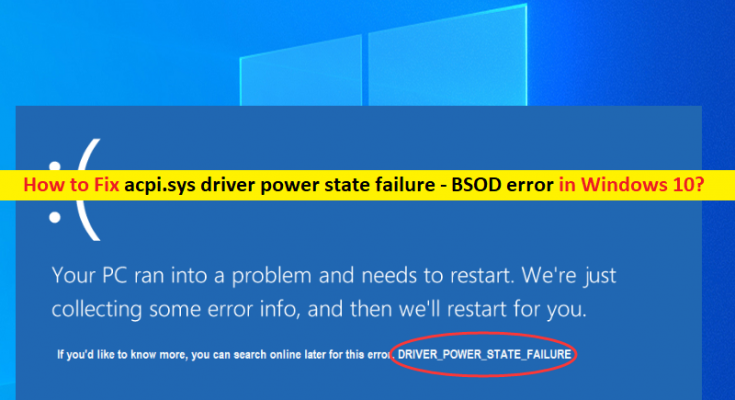What is ‘acpi.sys driver power state failure’ – BSOD error in Windows 10?
In this post, we are going to discuss on How to fix acpi.sys driver power state failure, acpi.sys error, acpi.sys boot error, Blue screen acpi.sys error, acpi.sys missing Windows 10. You will be guided with easy steps/methods to resolve the issue. Let’s starts the discussion.
‘acpi.sys driver power state failure’ – BSOD error: It is common Windows Problem considered as Blue Screen of Death (BSOD) error. This BSOD error is appeared with message saying ‘Your PC ran into a problem and needs to restart. We’re just collecting some error info and we’ll restart for you’ along with some Windows Stop Codes like Driver_Power_State_Failure or others. This error is usually appeared in the middle of your work on computer or when you start/restart your computer.
The possible reasons behind the issue can be the corrupted/outdated device drivers, outdated Windows OS, corruption in system files or registry, or in system image, corruption in RAM or memory, malware or viruses infections in computer, and other Windows issues. You should make sure all device drivers are properly installed in computer and are up-to-date to latest & compatible version.
Also, make sure Windows OS is up-to-date in computer to latest version. One possible way to fix the issue is to run system scan for malware or viruses in computer with some powerful antivirus software or PC Repair Tool offers you to find and remove all types of threats and fix Windows PC issues. It is possible to fix the issue with our instructions. Let’s go for the solution.
How to fix acpi.sys driver power state failure/ acpi.sys error/ acpi.sys missing Windows 10?
Method 1: Fix acpi.sys boot error/Blue screen acpi.sys error with ‘PC Repair Tool’
‘PC Repair Tool’ is easy & quick way to find and fix BSOD errors, DLL errors, EXE errors, problems with programs/applications, malware or viruses issues, system files or registry issues, and other system issues with just few clicks.
Method 2: Boot your computer in Safe Mode and uninstall recently installed device drivers

One possible way to fix the issue is to uninstall recently installed device drivers in Windows 10 safe mode.
Step 1: Restart your computer and when booting process initiates, press ‘F2’, ‘DELETE’ or other BIOS supported key on keyboard to enter into BIOS Settings page, and then make sure first boot device is set to your USB drive in BIOS
Step 2: Insert Windows 10 Installation Media USB into your computer and boot your computer with it
Step 3: When Windows Installation Media setup runs, select ‘Repair your computer’ option from screen and go to ‘Troubleshoot > Advanced Options > Command Prompt’, and type the following command, and then hit ‘Enter’ key to execute.
BCDEDIT /SET {DEFAULT} BOOTMENUPOLICY LEGACY
Step 5: Once executed, exit Command Prompt and restart your computer. Make sure Windows Installation Disc/USB is removed.
Step 6: Now, press ‘F8’ when booting initiates and select Safe Mode option to list of boot options to enter into Safe Mode
Step 7: Once you are in Safe Mode, open ‘Device Manager’ in Windows PC, right-click on device driver that you have recently installed, and select ‘Uninstall’ to uninstall them. Once done, restart your computer and check if the issue is resolved.
Method 3: Update Device Drivers in Windows PC
Updating all necessary drivers latest & compatible version can resolve the issue. You can try to update all Windows drivers to latest & compatible version using Automatic Driver Update Tool. You can get this tool through button/link below.
Method 4: Run SFC scan and DISM scan
You can run SFC scan and DISM scan in computer to repair corruption in system files and in system images in order to fix the issue.
Step 1: Type ‘cmd’ in Windows Search Box and press ‘SHIFT + ENTER’ keys on keyboard to open ‘Command Prompt as Administrator’
Step 2: Type the following commands one-by-one and hit ‘Enter’ key after each line to execute.
sfc /scannow
DISM.exe /Online /Cleanup-image /scanhealth
DISM.exe /Online /Cleanup-image /Restorehealth
Step 3: Once executed, restart your computer and check if the issue is resolved.
Method 5: Change Power Settings in Windows PC

Step 1: Open ‘Control Panel’ in Windows PC and go to ‘Power Options > Choose what the power buttons does > Change settings that are currently unavailable’
Step 2: Disable ‘Turn OFF Fast Startup (recommended)’, ‘sleep’, and ‘Hibernate’ options and then click ‘Save Changes’ to save the changes and once done, check if the issue is resolved.
Method 6: Change your power plan settings

Step 1: Open ‘Power Options’ using above method and click ‘Change Plan Settings’ next to your currently active plan
Step 2: Go to ‘Change Advanced Power Settings’. Open ‘Sleep’ section and make sure Sleep and Hibernate are set to ‘Never’. In ‘Power Buttons and Lid’ section, make sure everything is set to ‘Do nothing’ and then hit ‘Apply > Ok’ button to save the changes.
Step 3: You can also set ‘Graphics settings’ or ‘PCI Express and Lnk State Power Management’ to ‘Maximum Performance’. Do the same for ‘Wireless Adapter settings’, and check if issue is resolved.
Method 7: Disable or uninstall third-party antivirus/firewall
This issue can be occurred due to interference of third-party antivirus/firewall installed in your computer. You can disable your third-party antivirus/firewall in computer in order to fix the issue. If the disabling antivirus/firewall program didn’t work for you, you can uninstall your third-party antivirus/firewall completely in computer in order to resolve.
Method 8: Change Power Settings in NVIDIA Control Panel
If you are facing this issue on Windows PC with NVIDIA Graphics, then you can change Power settings in NVIDIA Control Panel in order to fix.
Step 1: Open ‘NVIDIA Control Panel’ in Windows PC via Windows Search Box and go to ‘Manage 3D Settings’
Step 2: Select your dedicated graphics card as ‘Preferred graphics processor’. Locate ‘Power Management mode’ in list of settings and select ‘Prefer maximum performance’.
Step 3: Click ‘Save Changes’ and check if the issue is resolved.
Method 9: Change device’s power options

Step 1: Open ‘Device Manager’ in Windows PC and expand ‘Network Adapters’ category
Step 2: Double-click on your network adapter driver to open its Properties
Step 3: Click ‘Power Management’ tab, uncheck ‘Allow the computer to turn OFF this device to save power’ and click ‘Ok’ to save the changes and once done, check if the issue is resolved.
Conclusion
I am sure this post helped you on How to fix acpi.sys driver power state failure, acpi.sys error, acpi.sys boot error, Blue screen acpi.sys error, acpi.sys missing Windows 10 with several easy steps/methods. You can read & follow our instructions to resolve the issue. That’s all. For any suggestions or queries, please write on comment box below.



